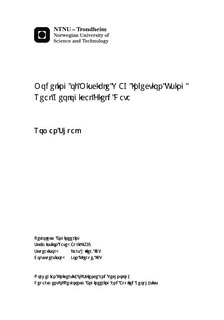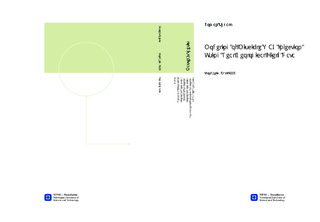| dc.description.abstract | Maximizing oil recovery is the challenge for the oil industry in the North Sea and world wide. Norwegian national company Statoil set the goal to reach oil recovery of 60% for their fields on NCS. To achieve this target a number of enhanced oil recovery technologies are being applied, including water alternating gas injection. The purpose of this study is to investigate the possibility of effective improvement of oil recovery with WAG injection for the field, which has high permeability zone in the upper part of the reservoir and has no dip. A dummy Eclipse 100 reservoir model, based on the geological model of Gullfaks segment K1/K2, was used. The original Gullfaks fluid was substituted with the fluid from SPE5 Comparative study. Miscibility of injection gas and reservoir oil was studied using the slim tube simulations with numerical simulator SENSOR by Coats Engineering. The results of simulations were compared with those obtained with equation of state based multicell procedure. The equation of state based calculations were conducted with PhazeComp, phase behavior modeling software by Zick Technologies. Numerical simulations of coarse grid segment, extracted from field scale model, were run to obtain the match between black oil model with Todd-Longstaff formulation of miscible displacement, and compositional model, by changing mixing parameter value. Grid refinement for compositional model was used to obtain more accurate results. The models were verified for depletion and water injection cases, and then compared for WAG injection cases with different cycles and injection rates. The simulations were run with Eclipse 100 and Eclipse 300.This segment model was used to study the effect of different completion schemes for this particular reservoir to find the most effective one. Changing completion scenario was proposed. Also the influence of different WAG design parameters was studied, including half-cycle length, number of cycles, injection rate. Simulations water alternating gas injection was also tested. The results were used for field scale modeling. For the field development modeling, 19 cases were constructed to study different WAG scenarios, including early time, late time and lifetime WAG injection. Different cycle lengths were studied, also including SWAG. Changing completion scenario was tested. All the cases were compared with water injection scenario. The influence of residual oil saturation on results was studied.Overall it was found that though water flooding is giving good results with high recovery, it is possible to improve recovery by up to 6.2 % (1.67 million Sm3 of oil) by using lifetime WAG injection, with produced oil per gas injected ratio in the range of 585 Sm3/MSm3. Late time injection can also be used, giving the recovery increase by 3.4 %. (1.125 million Sm3 of oil), with higher oil per gas ratio of 780 Sm3/Sm3. There is also high back production of injected gas (more than 80%). | nb_NO |

